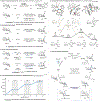Excited-State Palladium-Catalyzed Radical Migratory Mizoroki-Heck Reaction Enables C2-Alkenylation of Carbohydrates
- PMID: 35188768
- PMCID: PMC8970705
- DOI: 10.1021/jacs.1c13299
Excited-State Palladium-Catalyzed Radical Migratory Mizoroki-Heck Reaction Enables C2-Alkenylation of Carbohydrates
Abstract
Excited-state palladium catalysis has emerged as a promising strategy for developing novel and valuable reactions. Herein, we report the first excited-state Pd-catalyzed 1,2-radical migratory Mizoroki-Heck reaction that enables C2-alkenylation of carbohydrates using readily available 1-bromosugars and alkenes. The reaction tolerates a wide variety of functional groups and complex molecular architectures, including derivatives of natural products and marketed drugs. Preliminary mechanistic studies and DFT calculations suggest the involvement of visible-light-induced photoexcitation of Pd species, 1,2-spin-centered-shift (SCS) process, and Heck-type cross-coupling reaction. The reaction expands the reactivity profile of excited-state Pd catalysis and provides a streamlined protocol for the preparation of a wide variety of C2-alkenylated carbohydrate mimetics to aid the discovery and development of new therapeutics, agrochemicals, and materials.
Figures


References
-
- Varki A Essentials of Glycobiology; Varki A, Cummings RD, Esko JD, Stanley P, Hart GW, Aebi M, Darvill AG, Kinoshita T, Packer NH, Prestegard JH, Schnaar RL, Seeberger PH, Eds.; Cold Spring Harbor Press: 2017. - PubMed
-
- Jackman JE; Fierke CA; Tumey LN; Pirrung M; Uchiyama T; Tahir SH; Hindsgaul O; Raetz CR, Antibacterial Agents That Target Lipid a Biosynthesis in Gram-Negative Bacteria Inhibition of Diverse Udp-3-O-(R-3-Hydroxymyristoyl)-N-Acetylglucosamine Deacetylases by Substrate Analogs Containing Zinc Binding Motifs. J. Biol. Chem 2000, 275, 11002–11009; - PubMed
- Hang HC; Bertozzi CR, Ketone Isosteres of 2-N-Acetamidosugars as Substrates for Metabolic Cell Surface Engineering. J. Am. Chem. Soc 2001, 123, 1242–1243; - PubMed
- Li X; Uchiyama T; Raetz CR; Hindsgaul O, Synthesis of a Carbohydrate-Derived Hydroxamic Acid Inhibitor of the Bacterial Enzyme (Lpxc) Involved in Lipid a Biosynthesis. Org. Lett 2003, 5, 539–541; - PubMed
- Bernardi A; Cheshev P, Interfering with the Sugar Code: Design and Synthesis of Oligosaccharide Mimics. Chem. - Eur. J 2008, 14, 7434–7441; - PubMed
- Koester DC; Holkenbrink A; Werz DB, Recent Advances in the Synthesis of Carbohydrate Mimetics. Synthesis 2010, 2010, 3217–3242;
- Lepenies B; Yin J; Seeberger PH, Applications of Synthetic Carbohydrates to Chemical Biology. Curr. Opin. Chem. Biol 2010, 14, 404–411. - PubMed
-
- Flasch H, Bioavailability of Beta-Acetyldigoxin and Digoxin. Wien. Klin. Wochenschr 1975, 53, 873–877; - PubMed
- Rossini A; Like A; Dulin W; Cahill G, Pancreatic Beta Cell Toxicity by Streptozotocin Anomers. Diabetes 1977, 26, 1120–1124; - PubMed
- Som P; Atkins H; Bandoypadhyay D; Fowler J; MacGregor R; Matsui K; Oster Z; Sacker D; Shiue C; Turner H, A Fluorinated Glucose Analog, 2-Fluoro-2-Deoxy-D-Glucose (F-18): Nontoxic Tracer for Rapid Tumor Detection. J. Nucl. Med 1980, 21, 670–675; - PubMed
- Lu S; Li X; Wang A, A New Chiral Diphosphine Ligand and Its Asymmetric Induction in Catalytic Hydroformylation of Olefins. Catal. Today 2000, 63, 531–536.
-
- Timmers CM; Leeuwenburgh MA; Verheijen JC; van der Marel GA; van Boom JH, Rhodium (II) Catalyzed Asymmetric Cyclopropanation of Glycals with Ethyl Diazoacetate. Tetrahedron: Asymmetry 1996, 7, 49–52;
- Munyololo M; Gammon DW; Mohrholz I, Extending the Scope of the Ferrier Reaction: Fragmentation-Rearrangement Reactions of Selectively Substituted 1, 2-Cyclopropanated Glucose Derivatives. Carbohydr. Res 2012, 351, 49–55. - PubMed
Publication types
MeSH terms
Substances
Grants and funding
LinkOut - more resources
Full Text Sources
Miscellaneous

